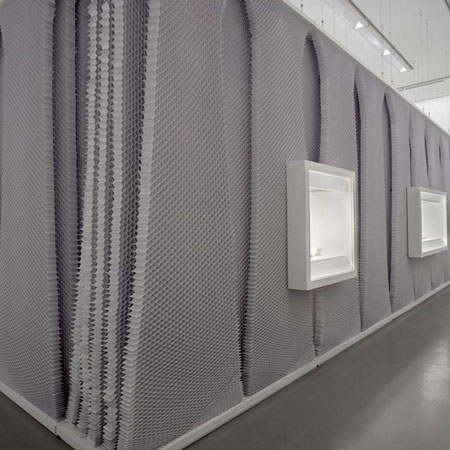Spanish/Mexican architects Cadaval & Solà-Morales designed an exhibition of works by artist Susana Solano at Fundación ICO in Madrid, made almost entirely of recycled materials.
The exhibition, displaying models of Solano's public artworks, ran from October last year until January this year.
See our earlier story about Cadaval & Solà-Morales' House on the Mexican Pacific Coast.
Here's an explanation of the project from Eduardo Cadaval of Cadaval & Solà-Morales:
"It is a project done following ecological and sustainable principles but now applied to exhibition design. The exhibition was on Susana Solano’s work, one of the most important Spanish artists (MOMA has several pieces of her). The main objective of the project was to create a 100% recyclable design; as you know, it is amazing the amount of materials and energy that are wasted on exhibition design and while some ecological measures are been taken regarding architecture or urbanism (LEED and others) it seems that exhibition design is floating on a limbo, where architects and designers, can waste energy and resources with no limit.
"So, when we accepted the commission to design this itinerary exhibition that started in Madrid’s ICO Foundation (on of the must prestigious exhibition spaces In Spain) we agreed with the client that we will search for more sustainable solutions. The result: one of the cheapest designs ever built by the ICO Foundation and the use of almost 100% of recycled material that could be recycled again once the itinerancy was over.
"This is the description of a project that aims to scale the space to the object that will be displayed, providing order and rhythm to an exhibition that wants to be intimate. The models of public sculptures done by Susana Solano are treated as jewels that relate to each other visually, as well as historically.
"A single system is designed to suit two spaces with opposed spatial attributes, allowing for a single reading of the exhibit. A unique envelope ought to unify spatial perception while solving the display of pieces by its layout.
"A fragile, white, translucent, almost sacramental envelope is build to receive a number of sturdy and powerful pieces. The reference is clear: the paper lamps used in fairs, made out of fragile honey comb paper, with its volume build up on air and inventiveness. From paper lamps to the recycled paper used inside wood doors (to reinforce them) there are a few hours of investigation, and the conviction to find in the paper industry a material that would fulfill our architectural aims, and be ecologically-friendly and economic.
"The technical and technological implications of the material drove to the definition of a standard module, build out of a couple of the mentioned standard doors and 5 layers of paper. A thick wall could be set up; its perpendicular view, creating a moaré, offered transparency within spaces and pieces; a tangent view would show a solid texture, building the limits of the constructed space, and frame the pieces. The attributes of the material depending on how it was approached were one of the key aspects of the project.
"The installation responded to ecological and sustainable issues. Not only the design was part of an itinerant exhibition, but even more, the main material used to build up was made up of recycled paper and could be recycled again. Moreover, decision on the material implied a radical decrease in costs."

